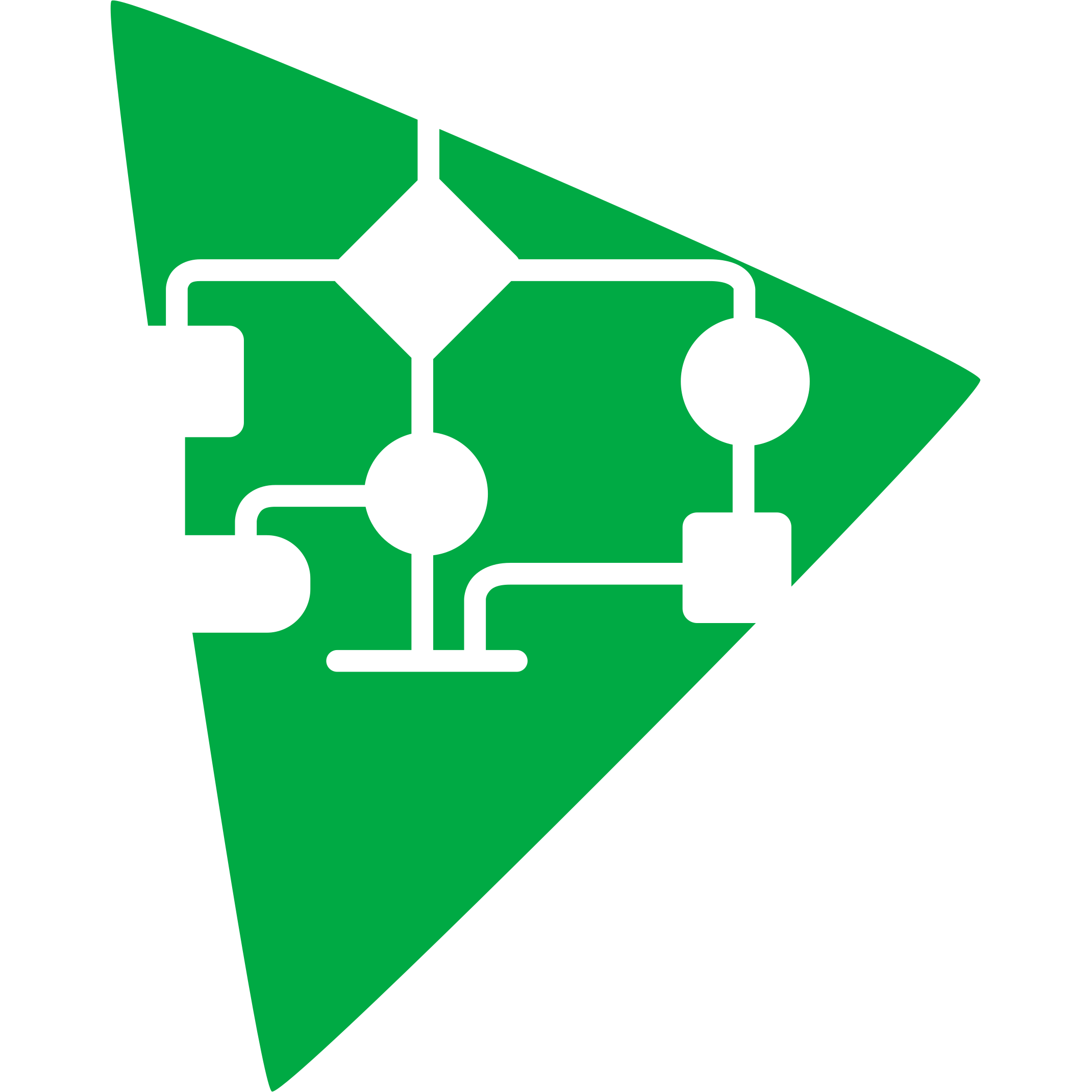The Finite-State Machine in kw patch-hub
Written by David Tadokoro , published on August 24, 2023My GSoC23 project (which I talked about in a previous post)
is about implementing a feature in kw that serves
as a hub for the public mailing lists archived on https://lore.kernel.org,
with a focus on patch-reviewing. The feature is called kw patch-hub and
I will talk about what are the lore archives and its API in a later post,
but in this post, I’m going to describe the Finite-State Machine model used on
this feature.
Finite-State Machines
Finite-State Machine (FSM), or Finite-State Automaton (FSA), is a mathematical model of computation that can be used to model a variety of problems, both for hardware and software.
This model is made of an abstract machine that can be on a finite number of states, but only one state is active at once. The machine receives inputs and a transition is the change from state A to state B when certain conditions are met. Notice that state A can be the same state as state B and that not every possible transition exists, in other words, not every state A has a transition that takes the machine to any other state B. In fact, it is possible for it to be no transitions, only states. An input can be considered any type of interaction with a machine, be it a human feeding characters to software (the machine), or a device (the machine) receiving signals from sensors.
Below, is a diagram of an FSM that has 4 states A, B, C, and D, and only receives inputs 0 and 1. The labeled circles represent the states and the arrows the transitions, the pointed end is the state that it’s being transitioned to. The 0s and 1s next to the arrows, represent the input needed for the transition to happen. Notice that we could omit transitions that take the machine to the same state, but this illustrates that not every input triggers a change of state.
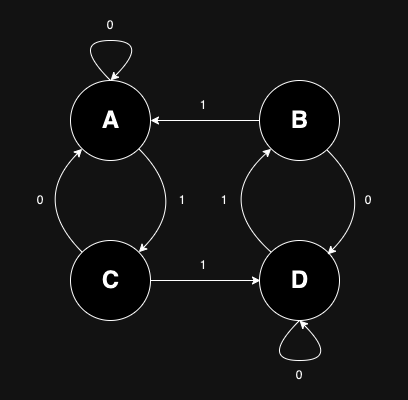
FSMs can be of two types: a deterministic Finite-State Machine (DFSM) and a non-deterministic Finite-State Machine (NFSM). An FSM is a DFSM if two restrictions are followed:
- Each transition is totally and uniquely defined by its starting state and the inputs necessary for the transition to happen.
- For a transition to happen, the FSM needs to receive input.
The previous diagram is also an example of a DFSM.
NFSMs don’t need to follow these restrictions, in fact, DFSMs are actually a subset of NFSMs. In simpler terms, For DFSMs, the machine only transitions between two states when well-defined inputs occur (that’s why it is called deterministic), and, for NFSMs, this isn’t true, so a transition between two states has a probability of happening with the machine receiving, or not, a set of inputs.
Below, is a diagram of an NFSM which is built upon the previous diagram. The only difference is that two transitions were added:
- From state A to state C by receiving 0.
- From state B to state C by receiving 1.
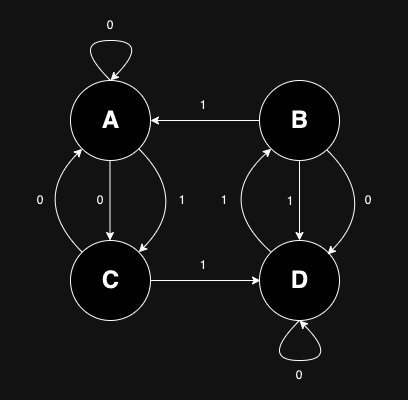
These additions turn the previous DFSM into an NFSM because the machine in state A can either transition to C or stay in state A by receiving 0. The same thing happens when the machine is in state B and receives 1, it can either transition to state A or state D.
kw patch-hub architecture
kw patch-hubis under development, so some details in this section may get outdated.
As with any other kw feature, kw patch-hub (link to man page)
has a dedicated file inside the src directory named patch_hub.sh that follows kw’s component structure.
This means that, at the top of the file, a function named patch_hub_main is defined,
which is the entry point of the feature, and, at the end of the file, the functions
parse_patch_hub_options and patch_hub_help are defined, which parses the options
passed to the feature and displays the feature’s help (either a short help or the
man-page), respectively. A simplified listing of src/patch_hub.sh is below:
include "${KW_LIB_DIR}/ui/patch_hub/patch_hub_core.sh"
function patch_hub_main()
{
if [[ "$1" =~ -h|--help ]]; then
patch_hub_help "$1"
exit 0
fi
parse_patch_hub_options "$@"
if [[ "$?" -gt 0 ]]; then
complain "${options_values['ERROR']}"
patch_hub_help
return 22 # EINVAL
fi
patch_hub_main_loop
return "$?"
}
function parse_patch_hub_options()
{
...
}
function patch_hub_help()
{
...
}
Notice in the listing above that, after entering the feature through patch_hub_main,
it first checks if the help should be displayed, then it parses the options, then it
calls the function patch_hub_main_loop, which is not defined in src/patch_hub.sh,
but rather in src/ui/patch_hub/patch_hub_core.sh.
Unlike any other kw feature that has all feature-specific actions handled by functions
defined in the same file, kw patch-hub goes in another direction and implements the
core of the feature in files at the src/ui/patch_hub directory.
That is because kw patch-hub is a screen-driven feature that displays screens using
dialog that transitions depending on the input
the feature receives. This results in many of the functions having a similar structure:
- Displaying a dialog screen.
- Collecting the necessary input.
- Setting the next screen to be displayed.
As such, implementing all these similar functions on the same source file would be a bad design choice. Maybe worse than that, implementing step 3 described above using a direct call to another function would make the call stack grow indefinitely.
The Finite-State Machine in kw patch-hub
After entering patch_hub_main_loop, kw patch-hub behaves as a Finite-State Machine,
in which the states are screens and its subscreens, and the transitions are the
setting of the screen_sequence['SHOW_SCREEN'] value. Below, is a simplified listing
of src/ui/patch_hub/patch_hub_core.sh:
declare -gA screen_sequence=(
['SHOW_SCREEN']=''
['SHOW_SCREEN_PARAMETER']=''
['PREVIOUS_SCREEN']=''
)
function patch_hub_main_loop()
{
local ret
# "Dashboard" is the default state
screen_sequence['SHOW_SCREEN']='dashboard'
# Main loop of the state-machine
while true; do
case "${screen_sequence['SHOW_SCREEN']}" in
'dashboard')
dashboard_entry_menu
ret="$?"
;;
'lore_mailing_lists')
show_lore_mailing_lists
ret="$?"
;;
'registered_mailing_lists')
show_registered_mailing_lists
ret="$?"
;;
'latest_patchsets_from_mailing_list')
show_latest_patchsets_from_mailing_list
ret="$?"
;;
'bookmarked_patches')
show_bookmarked_patches
ret="$?"
;;
'settings')
show_settings_screen
ret="$?"
;;
'patchset_details_and_actions')
show_patchset_details_and_actions "${screen_sequence['SHOW_SCREEN_PARAMETER']}"
ret="$?"
;;
esac
handle_exit "$ret"
done
}
Each case in the switch-case is a state in the FSM. A state is composed of a screen
and (maybe) subscreens. For example, the state dashboard is represented by only one
screen named ‘Dashboard’, as shown in the image below:
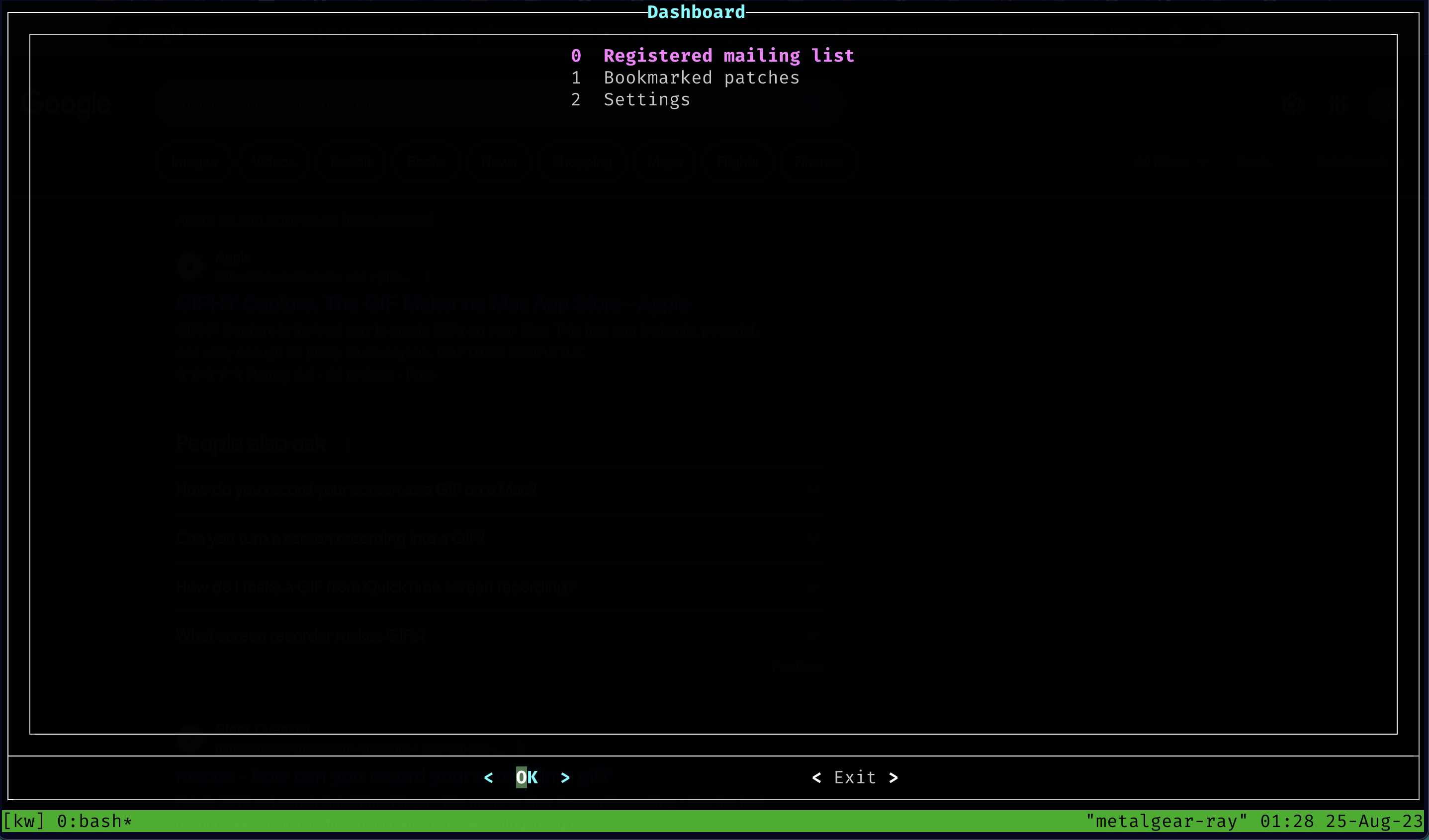
On the other hand, the state settings is represented by the ‘Settings’ screen, each
setting subscreen, and any auxiliary screen, as shown in the GIF below:
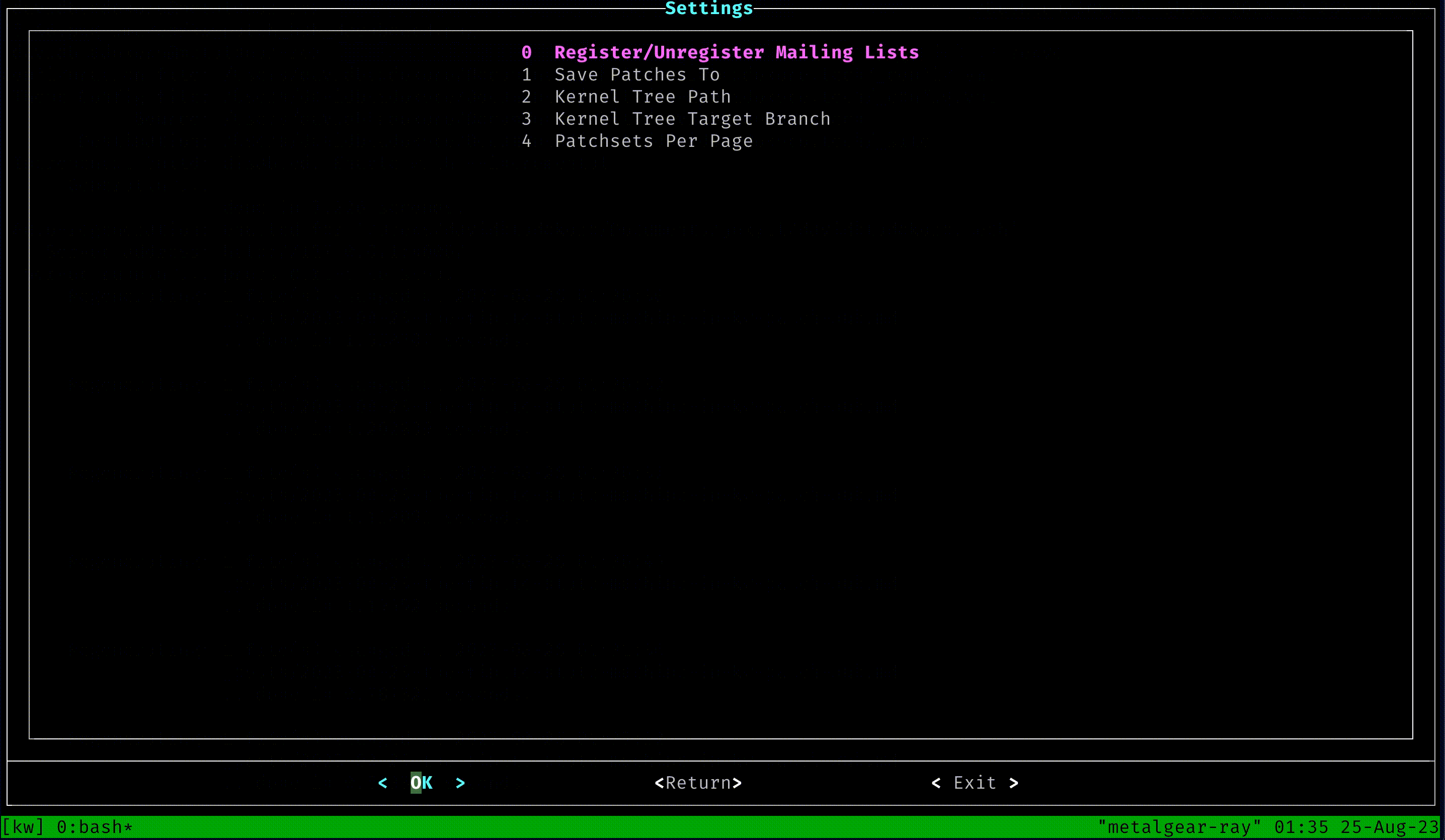
By selecting the option Save Patches To, a subscreen to select the path of the default
directory to save patches is displayed. Inside this screen, if the user hits the button
labeled ‘Help’, a help screen is displayed. If the option ‘Kernel Tree Target Branch’
is selected before setting ‘Kernel Tree Path’, a screen with an error message is displayed.
Both sequences described take the FSM from and to the settings state. At the end of the
GIF, the option ‘Register/Unregister Mailing Lists’ is selected, which takes the FSM from
the settings state to the lore_mailing_lists state.
Notice that in each iteration of the loop, the active state is determined and the
function that displays the necessary screen (and subscreens), collects the necessary
inputs, and transitions the FSM to another state if that is the case. To illustrate
this, look at this simplified listing of the dashboard_entry_menu function:
function dashboard_entry_menu()
{
local -a menu_list_string_array
local ret
menu_list_string_array=('Registered mailing list' 'Bookmarked patches' 'Settings')
create_menu_options 'Dashboard' '' 'menu_list_string_array'
ret="$?"
if [[ "$ret" != 0 ]]; then
complain 'Something went wrong when kw tried to display the Dashboard screen.'
return "$ret"
fi
case "$menu_return_string" in
0) # Registered mailing list
screen_sequence['SHOW_SCREEN']='registered_mailing_lists'
;;
1) # Bookmarked patches
screen_sequence['SHOW_SCREEN']='bookmarked_patches'
;;
2) # Settings
screen_sequence['SHOW_SCREEN']='settings'
;;
esac
}
The function create_menu_options displays a menu for the user to choose an option
between all available options (in this case, the elements of menu_list_string_array).
The interaction of the user with the screen by selecting an option results in the
menu_return_string variable storing the option number, from which the function
determines the next state by updating screen_sequence['SHOW_SCREEN'], or, in other
words, determines the transition that must happen.
It is worth noting that there are cases in which two different transitions can happen
with the same user interaction. For example, if there are no bookmarked patches
and the user selects the option ‘Bookmarked patches’ in the ‘Dashboard’ screen, a
message is displayed, then the FSM state reverts back to dashboard, instead of
the FSM transisitoning to bookmarked_patches and showing a screen with the list
of bookmarked patches, then waiting for the user interaction. Below, is a GIF showing
these two different transitions with the same user input:
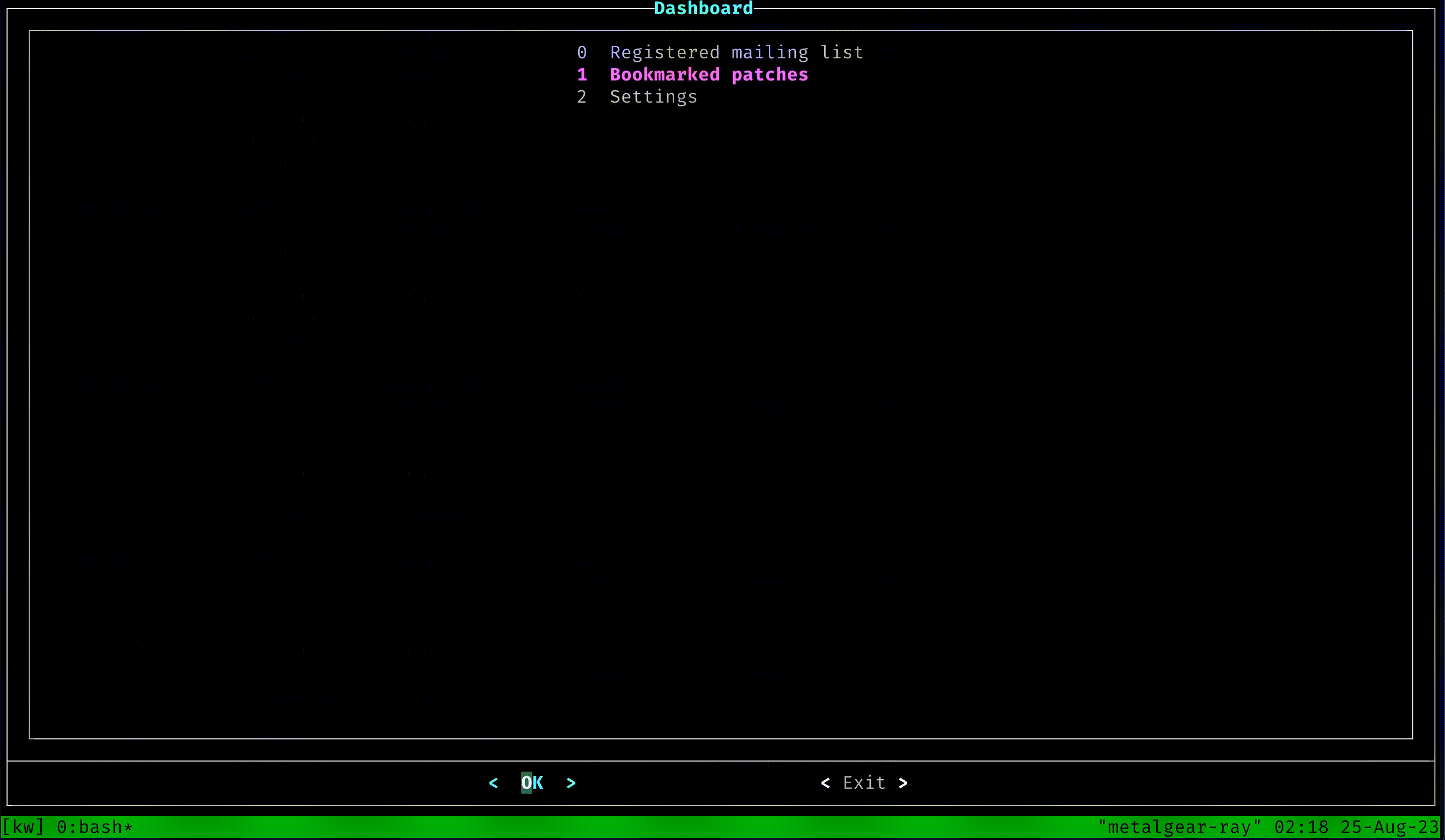
It is important to stress that kw patch-hub is an DFSM, because these different
transitions happen depending on the existence of bookmarked patches, which is also
an input to the FSM.
Conclusion
The Finite-State Machine model is simple to understand and implement. In the case
of kw patch-hub, adopting this model as the base of the feature was really beneficial,
as we can abstract the feature in these states represented by the screens/subscreens
and transitions, which makes the code less complex and easy to expand.
It is worth noting that the model isn’t strictly implemented wherever possible, as we could make the states more fine-grained by having a state for each and every type of screen. In my opinion, we could extract new states, but , if this extraction lowers the quality of the code, we should opt not to do it.
